Avoiding a drop in performance at shows and events
The majority of people who come to our advanced clicker classes are developing their clicker skills with a view to better performances at competitions. Initially they teach the dog hundreds of different, exciting behaviours, which is the usual early-learning disease when they get the active thumb (on the clicker.) Then this wave begins to crash when all these great new behaviours are taken to test circumstances and they seem to evaporate. The easy answer is to analyse that the dog is "insufficiently generalized," which means the learning has not been taken to enough situations and reinforced at that time.
Essentially I am quite a lazy trainer and I don't travel the dogs to lots of different places to generalize them. Also I have little opportunity to take my dogs to classes since I am usually teaching the class.
My dogs are all home-trained in their early learning, primarily the kitchen for small activities or the garden for the more spacious ones. Both would rate as the optimum places, with the garden sometimes throwing a "you can't expect me to lie there ....." (usually a non-clean piece of grass). This is deep country, with no traffic, other noises (except crows), other dogs, or animals (except sheep). The worst offence is someone shooting a rifle in the far distance which ends all learning from Kiwi, who is thunder-sensitive as well.
Over the past 20 years, this has been the usual pattern of learning for all the dogs in competition or general house learning and ALL the dogs are able to take the same piece of learning to a show, test, event, stage, demonstration—and are USUALLY BETTER than at home. The environment of my own excitement improves the performance (sometime to my cost!!).
Recently Arnold [a Gordon Setter] at 18 months went to Crufts for 2 days to demonstrate. The environment was extremely alien to a country boy who had only ventured to three low key dog shows previously and one evening's demonstration on a stage. He was a star, showing off and rather too "well up for it". No sign of diminished performance, just very responsive and rather naughty, as the demonstrations required.
There are some environments where the dog is overwhelmingly stressed. For example noise with my collie Kiwi. A hot air balloon finished Mabel [another Gordon Setter] on one occasion and proximity to a dog fight on another. I expect my dogs to do no less than their best, but equally I understand that they can be deeply upset by something outside their control; on these occasions we simply call it a day. On one occasion traveling to a dog show I very closely missed a head-on collision and stopped to help the people who hadn't. The entire day at the show I was highly distracted, lost most of my motor skills, and could not concentrate at all.
So when my students meet this problem I am rather at a loss to understand why they are getting a worse performance on test or stressful occasions.
We check:
1. Does the handler give the same cues and signals as in practice?
Very often the reason is that the handler either begins to "speak with loud hands", over-cues, or adds tension to the signals with tight shoulders. The handler can also do the opposite, when they go into themselves, and unintentionally "disengage" from the dog by focusing on their own actions and seeming to shut down. This is a strong inhibitor to the dog.
If neither of these situations are occurring, we then have to look at the environment from the canine angle and consider:
2. Are other dogs affecting / communicating assertively to your dog?
Again this can work negatively or positively. Some dogs will shut down when given the "eye" by a stronger dog, or respond to the challenge with enough attitude to frighten the Terminator. Either way, the performance is completely shot through.
In these situations, where the dog is "unbalanced" by the environment, asking the dog to respond to a well trained, finished and polished activity will:
- give the dog something to "do", and thus avoid a confrontation or expectation to react.
- give the dog a boost from the positive reinforcement of the exercise.
Karen Pryor's new "Click to Win" book contains an account of one of her master classes where she uses a previously well established favourite behaviour to reward a less confident new behaviour. When she was recently in the UK for a visit, we worked through this at our class.
We chose appropriate exercises for the dogs, such as standing on a wobbly table, backing under a cloth. We could all see the dog's hesitant but complying response when rewarded with the standard click and food. But when we changed to replacing the click with the cue for the favourite behaviour, within 2 or 3 tries the dogs had transferred the confidence and enjoyment from the favourite behaviour to the less favourite, so the wobbly tables were "just great", the back up into the cloth "a whiz".
This did not take many sessions to establish, just two or three goes.
So perhaps your show dog does not like the judge going past their shoulders with hand contact. You can change this by instead of a (plain) click and food, give the cue for "hi five" and click the hi-five action and reward.
Karen believes the reinforcement of a favourite action is stronger than the reinforcement of the plain click. Interesting, and yes it works.
Back to the drop in performance.
I was interested in the routines of other trainers who are successful, and checked that they experienced NO difference between their practice and their ring performance, in quality, response, or accuracy. Of the people I questioned (and we are talking seriously successful here) none of them "generalized" their training. They trained at home, or a favourite place in the park, and then went to shows.
BUT.
I took, quite accidentally, a friend, let's say Alice, who is constantly disappointed in her dog's ring performance to coffee with one of the previously mentioned successful handlers, let's say Maud. Still riding the "look what I've taught now" wave, Maud had to show us her latest trick with the new puppy. Very impressive.
Alice was gob-smacked. As a clicker trainer she was not surprised that Maud had taught the dog to play the piano, but that the dog was so very, very good at it.
As it turned out, Alice's home training was NEVER at the same standard as Maud's even for a mere "Sit", so of course the dog was performing less well in new situations. The training / learning / reinforcement was not even half way complete, even at home in the optimum learning environment.
So this leads me to want to ask questions:
1. If a dog is partway through the learning and the learning is "tested" (generalized) or put under stress by a strange factor (person or environment or noise) the performance is very likely to reduce. We usually expect the dog to go backwards and perform with reduced criteria.
Does this not alter the overall standard of that exercise?
2. While the dog learns a particular movement, action etc, let's say the "take a bow," in the optimum environment, in my classes the learning is shaped during "work in progress" with the cue of body language or hand signal or bowing yourself. Once the work in progress is complete and the behaviour is the best it can be, a new verbal cue is added ("bend") and reinforced in connection to only "the best".
The cue is strengthened by teaching the dog "bend" in conjunction with contrary signals, i.e. by standing up when you say bend, by waving an arm when you say bend, by turning your back when you say bend. I also strengthen the cue/action connection by asking for it at peculiar moments. When I pick up the kettle and walk to the sink, I look Quiz directly in the eye and give the "bend" cue. She usually blinks twice and initially verbalized back at me ("Get outta here!"). But now she can respond without hesitation.
Once the dog has experienced this process of cue transfer and "cue strengthening" on one or two behaviors, they are able to transfer the ability to other cues and actions. I don't need to practice the entire range of 28 actions whilst making coffee!
In conclusion
If the learning is sufficiently shaped and reinforced to the best it can be, and reliability is achieved at this level, and if then this standard is attached to a new "performance cue", there is no reason for the dog to give a reduced quality or reliability in show circumstances unless the stress level has gone beyond the dog's self management. Even then asking the dog for a strong, favourite behavior can reduce the stress significantly.
The experiment
I would like to see if a range of people, not just me and people under my supervision, can actually apply this idea and see whether it stands the test or not.
What you need
1. A place to hold your test.
This needs to be an environment that is only mildly stressful, uncomfortable or strange to the dog.
You need to be able to guarantee that you can visit this environment twice, once tomorrow and again in 30 days and at no time in between and that the environment will be EXACTLY the same on both occasions. So if you choose a supermarket car park at Friday lunchtime, then you need to return at exactly the same time of day for the second test. Your regular weekly dog club or show is not suitable.
2. A way to measure the response.
Devise a personal way of rating the response in terms of:
- hesitation between the giving of the cue and the response with the behaviour
- the quality of the behaviour
- the quality of the repetitions over 5 behaviors
I think a rating of 1 - 5 would be sufficient, i.e. pretty poor, not so good, average, better than average, excellent
3. Choose three different behaviours that you are confident have completed their Work in Progress phase. These behaviours in your optimum training environment CANNOT be improved upon and are already excellent in regards to:
- quick and correct response to the cue and
- the quality of the behaviour across 5 repetitions (you reward each one).
These could be simple behaviors such as sit, down, speak, beg etc. Choose single behaviors, not behaviour chains, or compound learning.
I would like you take the three behaviours to the chosen environment, carry them out, and rate them. Either video yourself, which is ideal for later comparison, or make notes.
Over the next 30 days you will choose a new cue for each of these behaviours, a single cue. Either change the word, or give a new hand shape, or even hold an object.
To teach the new cue, establish the behaviour to the acceptable standard, give the NEW cue, the OLD cue and then C&R. Make a gap between the new and old cue of at least three seconds.
The dogs will very soon begin to anticipate the behaviour and respond on the new cue. From here on, only allow your self a couple of further occasions to remind the dog with the old cue and then stick to the new cue only.
Reinforce the BEST behaviour following the NEW cue, at least once every day. Find a regular daily activity (putting the kettle on) to remind yourself to reinforce the sequence of the new cue with the best behaviour.
I would like to find out if
A behaviour trained to the best it can be, i.e. in need of no further improvement, when attached to a new cue that is sufficiently reinforced WILL NOT DETERIORATE UNDER STRESS.
So please help yourself and our competition dogs with a little experimentation. Keep the data, keep the evidence, please let me have feedback, and at no time hesitate to:
ASK QUESTIONS !!!!!!!
BE clear what you are doing before you start
BE clear what the objective is
If you are not sure about new cues here are some examples.
I have re-taught Arnold (Gordon Young Man) to Hi-five (off the ground) on the new cue "impossible" (i.e. "Who's impossible???) [i.e. from lying down position Arnold leaps straight into the air and slaps my hand, raised over my head, with his right front paw.]
In a down position: Put his chin on the floor on the new cue "shopping" (ie "Do you wanna go shopping?" To the audience he seems to be saying 'Oh no, not that!" )
Roll flat to his side on the cue "cricket" (i.e.Would you like a game of cricket? To the audience he is saying "Boring...") and from the roll flat, lift up one back leg vertically on the cue "think" ("What do ya think of Crufts??" To the audience, vulgar comment.)
Kay "no question is a stupid question" Laurence
Learning About Dogs
UK Clicker Training
Original Article - ©2002 Learning About Dogs/reprinted and edited here with permission.


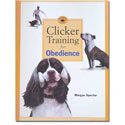
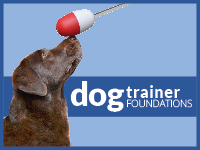
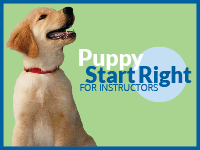
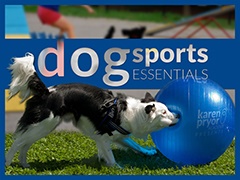
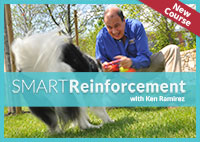

Post new comment